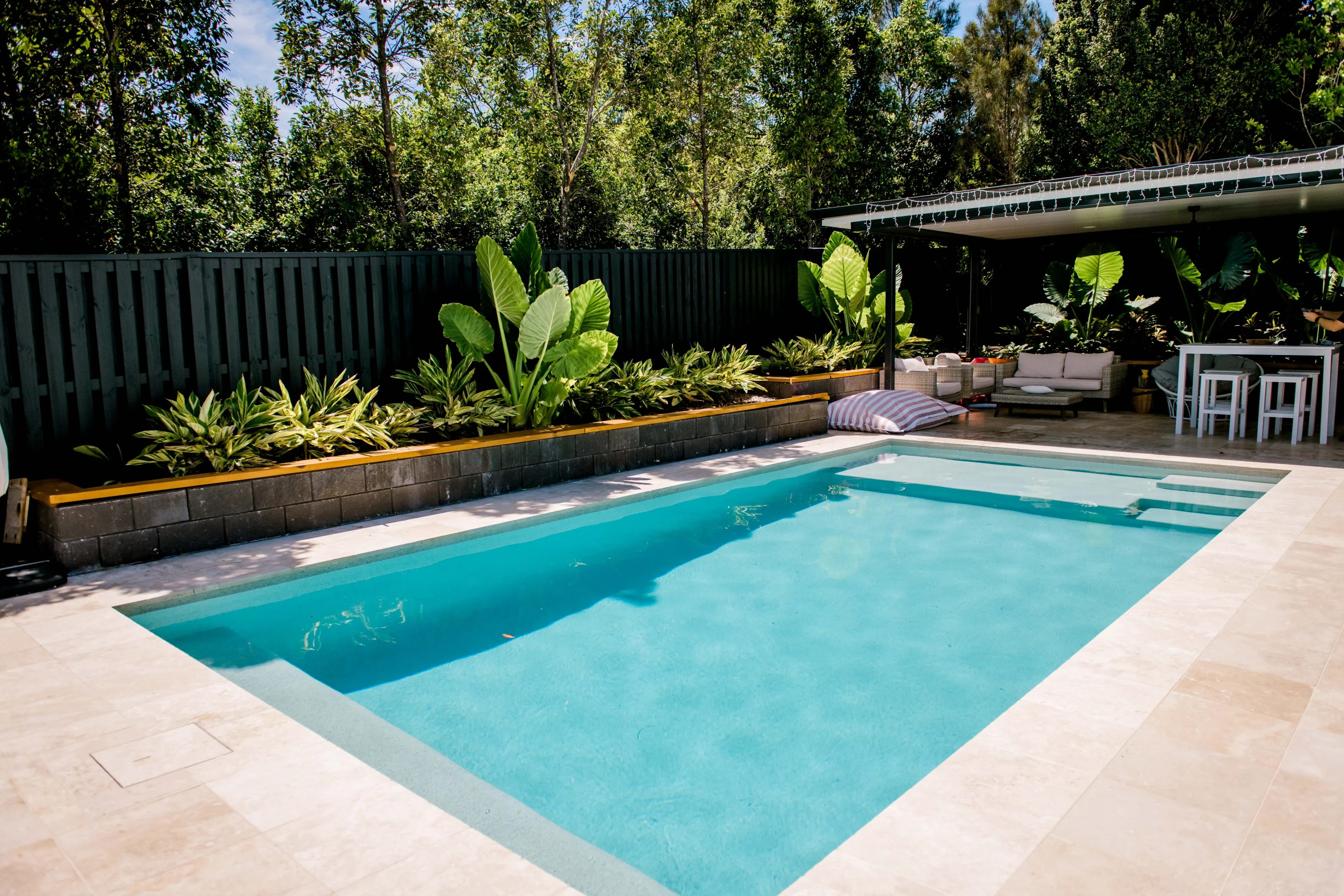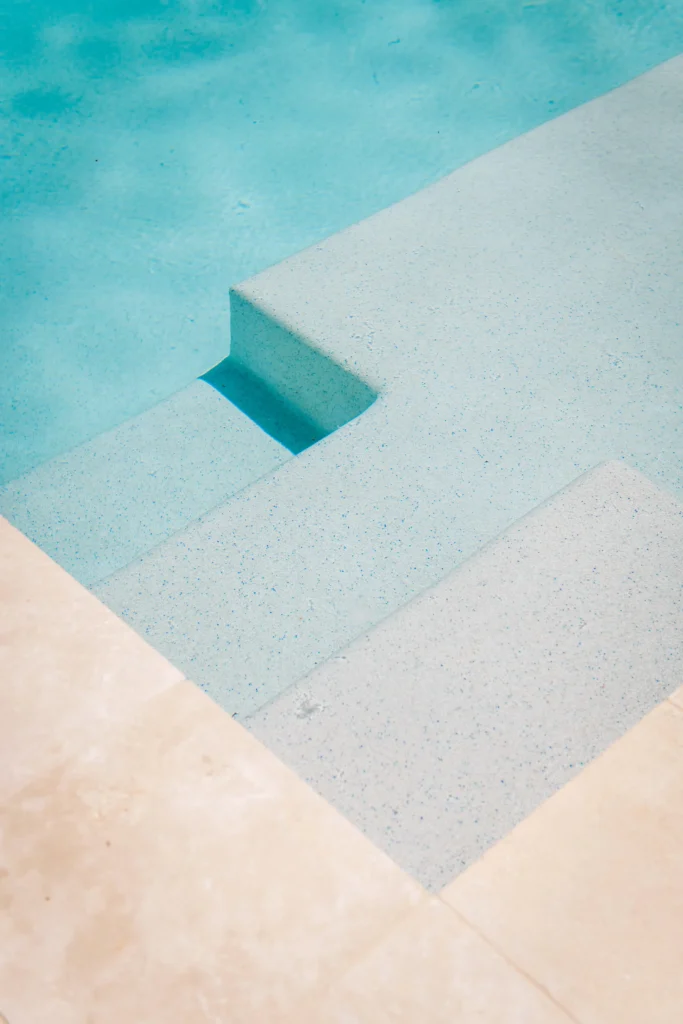
If you’ve started planning your new pool, you’ve likely hit the same question every homeowner faces: concrete or fibreglass?
It’s a choice that can shape not only how your pool looks, but how it feels, functions, and lasts over time.
Both pool types have earned their place in Australian backyards. Fibreglass pools are known for their convenience and classic look, while concrete pools offer way more design freedom and a custom fit for any space.
In this guide, we break down the real differences between concrete vs fibreglass pools, from cost and installation to design and durability.
We’ll show you exactly which pool type is the right fit for your home, your space, and the way you live.
Quick Comparison – Concrete vs Fibreglass Pools
Before diving into the finer details, here’s how concrete and fibreglass pools stack up side by side. This quick comparison highlights the main differences in design, cost, installation, and longevity, giving you a clear picture of what each pool type offers.
Feature | Concrete Pool | Fibreglass Pool |
Design Flexibility | Fully custom-built to suit any shape, size, or layout | Limited to pre-made moulds and sizes |
Aesthetic Options | Endless finishes and colours, including modern lighter tones | Restricted range of darker shell colours |
Installation Time | 8–12 weeks (varies by design and site) | 1–3 weeks (prefabricated shell) |
Durability | Extremely strong and long-lasting (30+ years) | Slightly shorter lifespan (typically 15–20 years) |
Maintenance | Moderate — occasional cleaning and resurfacing | Low short-term upkeep, but harder to repair if anything goes wrong |
Cost | Higher upfront, greater value at resale | Lower upfront, may cost more over time |
When you compare them side by side, both pool types deliver value in different ways.
What Is a Concrete Pool?
Concrete pools are built completely from scratch, giving you full control over the design, shape, and layout.
They’re formed on-site using a steel-reinforced framework that’s sprayed or poured with concrete, then finished with materials like tiles, pebblecrete, or rendered surfaces.
Because they’re custom-built, concrete pools can be designed to follow the flow of your property, from small plunge pools to large family designs or feature pools with infinity edges and integrated spas.
They’re also adaptable to almost any site, including sloping or uneven blocks where pre-made pool shells wouldn’t fit.
The result is a durable, long-lasting pool that becomes part of your home’s architecture. With the right care, a concrete pool can last for decades while keeping its structure, style, and value intact.
What Is a Fibreglass Pool?
Fibreglass pools are prefabricated shells manufactured in a factory and then transported to your property for installation. Each shell is made from a mould, which means the shape, size, and depth are fixed.
Once delivered, the shell is placed into an excavated hole, levelled, and plumbed, making installation quicker than a custom concrete build.
These pools come with a smooth, gel-coated interior that resists algae growth and offers a sleek finish. However, colour and finish options are limited to the manufacturer’s range, and lighter tones are less common.
Fibreglass pools suit homes with straightforward layouts and easy site access, particularly if a fast turnaround is important. While the shell can last many years, it can be harder to repair or replace if surface damage, fading, or warping occurs over time.
Pros and Cons of Concrete vs Fibreglass Pools
Every pool type comes with strengths and trade-offs. Understanding these helps you see how each performs in real-world conditions, from the build process to long-term upkeep.
Concrete Pool Pros
Concrete Pool Cons
Fibreglass Pool Pros
Fibreglass Pool Cons
When you weigh them up, fibreglass pools can offer convenience and speed, while concrete pools provide creative control, longevity, and a more seamless fit for your property.
Fibreglass vs Concrete Pool Cost
When comparing concrete and fibreglass pools, cost is often the deciding factor. While the upfront figures might look simple, the total expense depends on what’s included in the build, what needs to be added later, and how your site and design choices affect installation.
Upfront Installation Cost
While fibreglass appears cheaper at first glance, these prices usually cover basic installation only. Extra features, site preparation, or access equipment can quickly narrow the price gap.
Additional and Hidden Costs
Even with standard pricing, both pool types can attract add-ons that change the final figure:
Finishes and Aesthetic Costs
Concrete pools offer full creative control, from pebblecrete and tiles to custom colours and waterline features, all of which influence price.
Fibreglass pools come in fixed finishes and colours. While this keeps costs predictable, it limits design choice and may not suit every home’s style.
If you prefer lighter, modern finishes or want a pool that blends seamlessly with your landscape, concrete provides more options, even if it comes with a higher initial investment.
Cost Over Time
It’s worth considering how each pool’s value changes over time:
Across their lifespans, both pool types can deliver value in different ways, whether through lower initial costs or longer-term durability.
Is Concrete or Fibreglass Right for You?
Every homeowner has different goals when planning a pool. Some want a quick, cost-effective installation. Others want a custom feature that enhances their home’s design and value.
Here’s exactly how to decide which option best fits your situation.
Choose a Concrete Pool If…
- You want a pool that can be designed and built to any shape, size, or depth.
- Your site is sloping, narrow, or has unique access or elevation challenges.
- You’d like your pool to match your home’s architecture or landscaping.
- You want freedom to choose your finishes, from tiles and pebblecrete to smooth render.
- You prefer lighter, modern finishes that aren’t available with fibreglass.
- You’re planning to stay in your home long-term and want your pool to add value to your property
- You want the flexibility to integrate features like steps, ledges, spas, or infinity edges.
Concrete pools suit homeowners who want a purposeful, design-driven feature that feels like part of their home, not an addition to it.
Choose a Fibreglass Pool If…
- You prefer a faster installation and a more predictable build timeline.
- You’re comfortable selecting from a range of pre-made shell shapes and sizes.
- You have a flat, accessible site that doesn’t need major excavation.
- You’re working to a tighter budget and want lower upfront costs.
- You want a low-maintenance option that’s ready to swim in sooner.
Fibreglass pools suit homeowners who want simplicity, speed, and a set design that delivers quick results with minimal construction.
Concrete vs Fibreglass Pools: When Either Option Works
Some homes are suited to both pool types. In these cases, your priorities will help you decide:
Aqua Living Pools Advice:
Both pool types can deliver great results when chosen for the right reasons.
If you want a pool that feels personal, is designed for your home, and is built to last, concrete pools are easily the best option and offer the greatest potential.
If you prefer a faster installation and a fixed design, fibreglass can deliver a solid result with less complexity.
Common Myths About Concrete and Fibreglass Pools

There’s plenty of mixed information online about concrete and fibreglass pools. Some of it’s outdated, and some is simply wrong.
Before you decide which pool type to get, you should debunk some of the common myths flying around:
Myth 1: Concrete pools always crack.
Modern concrete pools are engineered with reinforced steel and advanced construction techniques that significantly reduce cracking. Hairline surface marks can appear over time but are typically cosmetic and easy to repair. With proper construction and maintenance, a concrete pool can stay structurally sound for decades.
Myth 2: Fibreglass pools are maintenance-free.
While fibreglass pools are low-maintenance, they’re not maintenance-free. Water chemistry still needs to be balanced, and the gel coat surface can fade or blister with exposure and age. Maintenance is simply different, not nonexistent.
Myth 3: Concrete pools cost twice as much.
Concrete pools do cost more upfront, but the difference often isn’t as large as people expect once site preparation, crane hire, and landscaping for fibreglass are included. Over time, a concrete pool’s lifespan and resale value often balance the investment.
Myth 4: Fibreglass pools are safer because the surface isn’t rough.
Fibreglass shells have a smooth finish, but they can become slippery, especially when wet. Concrete finishes can be textured or sealed for better grip, making them equally safe and comfortable underfoot.
Each pool type has evolved over the years, and the technology behind both is far more advanced than it once was. The key difference now comes down to customisation, longevity, and design flexibility.
Start Your Concrete Pool Project with Aqua Living Pools
Now that you understand the real differences between concrete and fibreglass pools, you can see why more Australian homeowners are choosing concrete for long-term value, design freedom, and a seamless fit with their property.
At Aqua Living Pools, we specialise in building custom concrete pools that are designed around your lifestyle and your home, not a template.
Every project is built to last, combining architectural design with precision construction to create a pool that feels like it’s always been part of your space.
Whether you’re after a modern plunge pool, a statement family pool, or something unique, we can help you bring it to life.
Contact our experienced team online today or call 1300 931 300 and discover how we can turn your vision into a space built for living.


